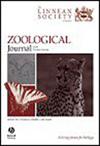穴居蜉蝣幼虫下颌象牙的功能形态研究:微计算机断层扫描和三维形态测量学分析
IF 2.8
2区 生物学
Q1 ZOOLOGY
引用次数: 0
摘要
蜉蝣超科是一种多样的穴居蜉蝣,以其幼虫期下颌长牙的形态和行为独特性而闻名。在这项研究中,我们利用显微计算机断层扫描的三维形态测量技术结合点云配准自动标记的创新方法,研究了Ephemeroidea所有六个象牙科的下颌象牙的功能形态。我们的研究结果在数量上支持并完善了Bae和McCafferty在1995年提出的假设,即曲率和坚固性在功能上与象牙适应性有关。对下颌象牙和前腿的主成分分析证实了三种居住形态的分组(间质,穴居和硬基质穴居居民)。基于目前蜉蝣科系统发育的进化趋势表明,具有扁平身体的间隙居民可能是在Potamanthidae和Euthyplociidae的基础谱系中进化而来的,而具有圆柱形身体的穴居居民,例如在多丝蝇科和蜉蝣科的大多数基础谱系中,以及硬底居民,例如Povilla-Ashenopus(多丝蝇科)和Cheirogenesia-Palingenia (palingenidae),似乎是平行进化的。前腿的挖洞效率更高。这些发现为底栖大型无脊椎动物中这些独特结构的功能和生态适应性提供了全面的见解。本文章由计算机程序翻译,如有差异,请以英文原文为准。
Revisiting the functional morphology of mandibular tusks in burrowing mayfly larvae (Insecta: Ephemeroptera): analysis using micro-computed tomography and 3D morphometrics
The superfamily Ephemeroidea is a diverse group of burrowing mayflies known for the morphological and behavioural uniqueness of their mandibular tusks during their larval stage. In this study, we investigated the functional morphology of mandibular tusks across all six tusked families of Ephemeroidea using 3D morphometrics from micro-computed tomography combined with an innovative method of automatic landmarking via point-cloud registration. Our findings quantitatively support and refine the hypothesis of Bae and McCafferty in 1995 revealing that curvature and robustness are functionally linked to tusk adaptations. A principal component analysis of the mandibular tusks and forelegs substantiated the grouping of the three dwelling morphotypes (interstitial, burrowing, and hard-substrate burrowing dwellers). Evolutionary trends based on the current Ephemeroidea phylogeny suggest that interstitial dwellers with flattened bodies might have evolved in the basal lineages of Potamanthidae and Euthyplociidae, whereas burrowing dwellers with cylindrical bodies, such as that in most basal lineages of Polymitarcyidae and Ephemeridae, as well as hard-substrate dwellers, such as Povilla—Ashenopus (Polymitarcyidae) and Cheirogenesia—Palingenia (Palingeniidae), appear to have evolved in parallel, with enhanced burrowing efficiency with the forelegs. These findings provide comprehensive insights into the functional and ecological adaptations of these unique structures among benthic macroinvertebrates.
求助全文
通过发布文献求助,成功后即可免费获取论文全文。
去求助
来源期刊
CiteScore
6.50
自引率
10.70%
发文量
116
审稿时长
6-12 weeks
期刊介绍:
The Zoological Journal of the Linnean Society publishes papers on systematic and evolutionary zoology and comparative, functional and other studies where relevant to these areas. Studies of extinct as well as living animals are included. Reviews are also published; these may be invited by the Editorial Board, but uninvited reviews may also be considered. The Zoological Journal also has a wide circulation amongst zoologists and although narrowly specialized papers are not excluded, potential authors should bear that readership in mind.

 求助内容:
求助内容: 应助结果提醒方式:
应助结果提醒方式:


